During the First World War, the Newfoundland Regiment fought valiantly. Despite the dangers, the men of the Regiment distinguished themselves in many battles. Two hundred and twenty three (223) Newfoundland and Labrador soldiers received a total of 285 military commendations.
Rickett's Investiture
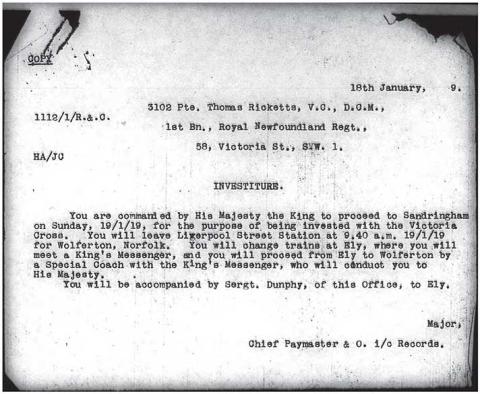
The Rooms Provincial Archives Regimental File #3102
As a whole, the Regiment's bravery was also recognized. Two weeks after the Battle of Cambrai (November 20 to December 6, 1917), King George V granted the title of "Royal" to the Newfoundland Regiment for its efforts in that battle and the Third Battle of Ypres (1917). This was the only time this honour was given during the First World War.
Perhaps more important is the trust that other British soldiers had in the Regiment. It gained a reputation as a dependable, disciplined fighting force. In fact, when British Brigadier-General Freyberg learned his left was being protected by the Newfoundland Regiment during fierce fighting in the Steenbeck in October 1918, he exclaimed, "Thank God, my left flank is safe!"
British Awards
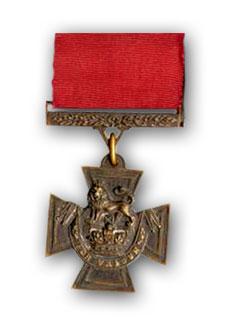
Victoria Cross (VC)
The Victoria Cross was introduced in the British Army in 1856 as the highest award for gallantry, available to all ranks. It was created by Queen Victoria and inspired by some of the wounded soldiers she met in the Crimean War. Thomas Ricketts was the only member of the Royal Newfoundland Regiment to receive this prestigious award. In total, 633 Victoria Crosses were awarded during the First World War.
The medal is a cross pattée (that is, a cross with arms which are narrow at the centre, and broader at the perimeter), 1.375 inches (35 milimetres) in width. Tradition holds that it is made from Russian cannons captured during the Crimean war. However, post-1914 medals are made from Chinese guns likely captured during the Second Anglo-Chinese War of 1860. The picture engraved on the front of the cross shows the Royal Crown "guarded" by a lion on top. Below the crown is a scroll inscribed with the words "For Valour". The cross hangs from red ribbon, 1.5 inches (38 milimetres) wide, which is finished with a metal bar engraved with laurels. The recipient's service number, rank, name, and regiment or ship are engraved on the reverse of this metal mounting bar. The date of the action that prompted the award is engraved on the reverse of the Cross. A bar can be added to the Victoria Cross for additional acts of bravery, but this is extremely rare.
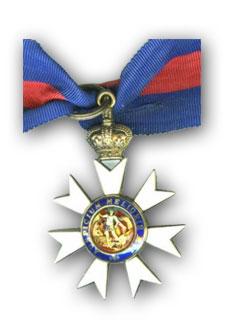
The Order of St. Michael and St. George - Companion (CMG)
Instituted in 1818 to acknowledge service in Malta and the Ionian Islands, this order has expanded to recognize extraordinary se
rvice to British interests abroad. Although it is usually conferred on those performing diplomatic service, a number of military personnel received this commendation during the First World War. There are three classes in the order: Knights and Dames Grand Cross (GCMG); Knights and Dames Commander (KCMG / DCMG); and Companions (CMG). Two members of the Royal Newfoundland Regiment received the Companion of the Order of St. Michael and St. George during the First World War.
The commendation is a seven-armed, white enamel version of the Maltese Cross (a symbol of an order of Christian warriors known as the Knights Hospitaller). The centre of the cross is a circle ringed in blue with the motto: "AUSPICIUM MELIORIS ÆVI" (Token of a better age). Inside the circle is a representation of St. Michael the Archangel holding a flaming sword and trampling on Satan. The reverse of the medal shows St. George on horseback killing a dragon.
The Order of the British Empire
King George V established the Order of the British Empire in June 1917. The main intent was to recognize outstanding service to the war effort by civilians at home and servicemen in support positions. Notably, women and foreigners were also included. The Order has five levels. The first two levels confer knighthood. The other levels are Commander, Officer, and Member.
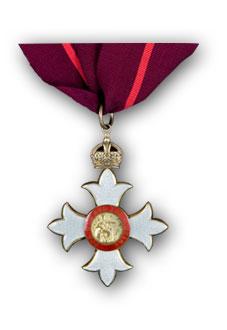
Commander of the British Empire (CBE)
Three members of the Royal Newfoundland Regiment received the Commander of the Order of the British Empire in the First World War. The commendation consists of a silver-gilded cross beneath the Imperial Crown. Each arm of the cross has three points and is covered with pearl-grey enamel. At the centre is a gold circle, ringed by a red band containing the motto "For God and Empire". In the centre of the circle is the figure of Britannia holding a trident and seated next to a shield bearing the Union flag. The reverse side of the medal shows King George V's Royal and Imperial Cypher. (A Royal and Imperial Cypher is a mark used on royal and state documents. It consists of the Sovereign's initials, often shown beneath a crown.) Before 1937, the commendation was worn on a purple ribbon with a narrow red stripe in the centre. (Civilians wore the award on an all-purple ribbon.)
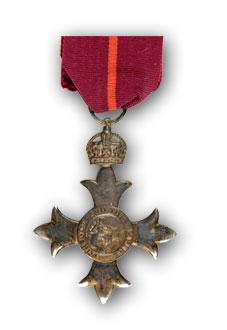
Officer of the British Empire (OBE)
Eight members of the Royal Newfoundland Regiment received the Officer of the Order of the British Empire in the First World War. The commendation looks the same as the Commander of the British Empire commendation, except that it is entirely silver gilt.
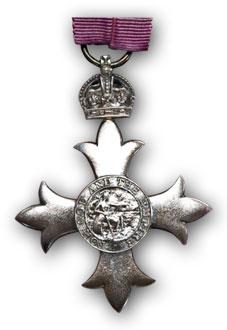
Member of the British Empire (MBE)
Nine members of the Royal Newfoundland Regiment received the Member of the Order of the British Empire in the First World War. The commendation looks the same as the Commander of the British Empire commendation, except that it is matt silver.
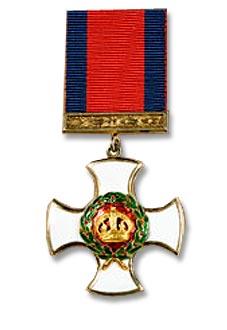
Distinguished Service Order (DSO)
This medal was established in 1886 to award officers who performed meritorious or distinguished service in war, usually during actual combat with the enemy. In order to qualify for this medal, an officer had to have been "Mentioned in despatches". A Bar to Distinguished Service Order could be received for subsequent acts of bravery. In the First World War, three members of the Royal Newfoundland Regiment received the Distinguished Service Order. Awards of this medal were announced with citation in theLondon Gazette.
This medal is a gold cross with white enamel on the obverse. At the centre of the cross is a red circle decorated with a gold Imperial Crown. A green enameled wreath surrounds the circle. The reverse of the medal shows the Royal Cypher (monogram of the Sovereign) against a red enameled background that is encircled by a green enamel wreath. The medal is displayed on a red ribbon with narrow blue edges. A gold bar decorated with laurels finishes the top and bottom of the ribbon.
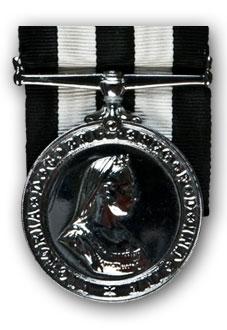
Royal Victorian Medal
Queen Victoria created this commendation in 1896 as a way for her to reward personal service to the Sovereign. It is given by the Sovereign's own initiative rather than by ministerial recommendation. One member of the Royal Newfoundland Regiment became a Member of the Royal Victorian Order in the First World War — the Regiment's Bandmaster.
Unlike the Maltese cross of the Royal Victorian Order to which it is related, the Royal Victorian Medal is circular. Awarded in silver gilt, silver and bronze, the obverse shows the effigy of the reigning Sovereign while the reverse gives the Royal Cypher.
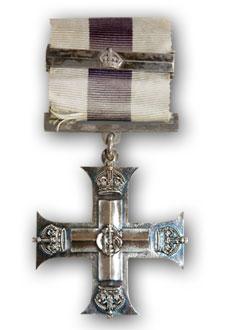
Military Cross (MC)
The Military Cross was established as a military commendation in December 1914 as a way to honour gallant and distinguished services in action by commissioned officers at or below the rank of Captain (or Warrant Officer). A Bar to the Military Cross can be received for subsequent acts of bravery. This silver bar, decorated with an Imperial Crown in the centre, is worn across the medal's ribbon. In the First World War, 30 members of the Royal Newfoundland Regiment received the Military Cross. Six of these recipients also received a Bar to their Military Crosses. Awarding of this medal was announced with a citation in the London Gazette.
This medal is a silver cross, 1.75 inches (44 milimetres) wide. The Royal Cypher (monogram) of the reigning sovereign decorates the cross's centre. At the end of each arm of the cross is an Imperial Crown. The reverse of the medal is plain. The medal is displayed on a white ribbon with a purple stripe in the centre.
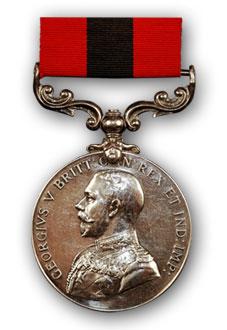
Distinguished Conduct Medal (DCM)
This commendation is the second highest medal awarded for gallantry for all army ranks below commissioned officers. It was created in 1854, during the Crimean War, and was awarded to Warrant Officers and non-commissioned officers and men for "distinguished conduct in the field". A Bar to Distinguished Conduct Medal could be received for subsequent acts of bravery. This silver bar, decorated with laurels, is worn across the medal's ribbon. In the First World War, thirty onemembers of the Royal Newfoundland Regiment received the Distinguished Conduct Medal. One of these recipients also received a Bar. Awarding of this medal was announced with a citation in the London Gazette.
The Distinguished Conduct Medal is a circular silver medal, 1.42 inches (36 milimetres) in diameter. It features a picture of the Sovereign. During the First World War, this medal depicted a bare-headed King George V in a Field Marshall's uniform and the legend: GEORGIVS V BRITT: OMN: REX ET IND : IMP. The reverse of the medal has the words "For Distinguished Conduct in the Field" above a small oval wreath with a line through it. The medal is displayed on a red ribbon with a dark blue stripe in the centre. The ribbon is attached to the medal by a single-toe claw between two scrolls. The recipient's regimental number, rank, unit number, initials, and surname are engraved around the edge of the medal.
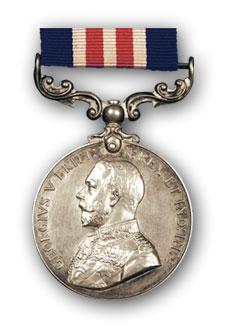
Military Medal (MMMilitary Medal) (MM)
This commendation was created by King George V in March 1916 as a way to acknowledge acts of bravery in war that were not of sufficient merit to receive a Distinguished Conduct Medal. This medal could be awarded to Warrant Officers, non-commissioned officers, and men on the recommendation of a Commander in Chief in the field. A Bar to the Military Medal could be received for subsequent acts of bravery. (This silver bar, decorated with laurels, is worn across the medal's ribbon.) In the First World War, 108 members of the Royal Newfoundland Regiment received the Military Medal. Eight of these recipients also received a Bar to their Military Medal.
The Military Medal is a circular, silver medal, 1.42 inches (36 milimetres) in diameter. It features a picture of the Sovereign. During the First World War, this medal depicted a bare-headed King George V in a Field Marshall's uniform and the legend: GEORGIVS V BRITT: OMN: REX ET IND : IMP. The reverse of the medal has the words "For Bravery in the Field", circled by a laurel wreath with the Royal Cypher and Imperial Crown on top. (A Royal and Imperial Cypher is a mark used on royal and state documents. It consists of the Sovereign's initials, often shown beneath a crown.) The medal is displayed on a dark blue ribbon with five equal centre stripes of white, red, white, red, and white. The ribbon is attached to the medal by a single-toe claw between two scrolls. The recipient's regimental number, rank, unit number, initials, and surname are engraved around the edge of the medal.)
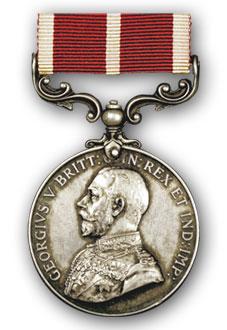
Meritorious Service Medal
This commendation was originally created in 1845 as a way to recognize long military service. However, in 1916 it became used to honour acts of gallantry or meritorious conduct when not in the face of the enemy. In the First World War, 14 members of the Royal Newfoundland Regiment received the Meritorious Service Medal. (Three members of the Newfoundland Forestry Corps were also recipients.) Awards of this medal were announced in the London Gazette.
The Meritorious Service Medal is a circular, silver medal, 1.42 inches (36 milimetres) in diameter. It features the head of the Sovereign. The reverse of the medal shows a crown and wreath with the words: "For Meritorious Service". A Bar to the Meritorious Service Medal could be awarded for subsequent acts of gallantry. The medal is displayed on a red ribbon, which is edged in white and has a narrow white stripe running through the centre. The ribbon is attached to the medal by a single-toe claw between two scrolls.
Mentioned in Despatches
Soldiers in the British Army could be recognized for a specific action by being "Mentioned in despatches" (an official report from a Commander-in-Chief). Although this was not actually considered a medal, soldiers "Mentioned in despatches" in the First World War received both a certificate and, in 1920, an emblem of a bronze oak leaf. The latter was to be attached to the ribbon of the Victory Medal (or the War Medal if a Victory Medal had not been issued). Those "Mentioned in despatches" were also noted in the London Gazette. In the First World War, twenty-five members of the Royal Newfoundland Regiment were "Mentioned in despatches".
Honourable Mention to Secretary of State for War
Soldiers in the British Army could also be recognized for a specific action by being mentioned in a report to the Secretary of State for War. In the First World War, ten members of the Royal Newfoundland Regiment received an Honourable Mention to Secretary of State for War. A Certificate of Mention in the London Gazette was mailed to the soldier.
Foreign Awards
In times of war when nations are allied and working together on military operations, a soldier may receive a medal from a country other than his/her own. In the First World War, twenty-two members of the Royal Newfoundland Regiment received medals from Allies of the United Kingdom.
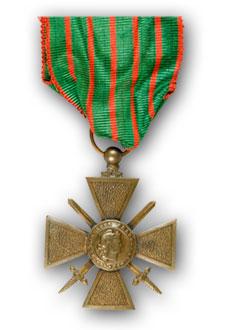
Croix de Guerre (War Cross - French)
This commendation was created by the French Government in April 1915 to commemorate acts of heroism in the face of the enemy that merited a mention in a despatch (an official military communication). The award could be issued to both individuals and units and was open to army, navy, and air force personnel in the French service or in the service of an Allied army.
The Croix de Guerre awarded to an individual is a bronze cross, 37 milimetres wide, with two bronze swords crossed diagonally at its centre. A bronze disc bearing the head profile of Marianne — a woman who symbolizes the French Republic — completes the centre. The back of the medal reads 1914 above and between 1915 and 1918 on the bottom, depending on when the medal was made. For the First World War, the medal was worn from a green ribbon ribbed with seven red stripes. (A different ribbon was used in the Second World War.)
There are several levels of the Croix de Guerre, each determined by the level of the despatch citing the act of bravery. Each level is marked by a pin on the ribbon as follows: Army despatch — small bronze laurel branch (Palme en bronze); Army Corps despatch — silver gilt star (étoile en vermeil); Divisional despatch — silver star (étoile d'argent); Brigade, Regimental, or similar Unit despatch — bronze star (étoile de bronze). As every mention is represented by a pin, more than one pin may be worn on a ribbon. For every five bronze palms awarded, a soldier instead gets a silver palm.
In the First World War, four members of the Newfoundland Regiment were awarded the Croix de Guerre; one received the Croix de Guerre avec Étoile d'Or; one received the Croix de Guerre avec Étoile d'Argent; and three received the Croix de Guerre avec Étoile de Bronze.
Médaille d'honneur des affaires étrangères / Foreign Affairs Medal of Honour
Médaille d'honneur avec glaives en bronze / Medal of Honour with Bronze Swords
This commendation was created in 1887 for the French Ministry of Foreign Affairs to honour acts of courage by French citizens abroad or foreigners. During the First World War, Ernest Gullicksen of the Newfoundland Regiment won the Médaille d'honneur avec glaives en bronze (the Medal of Honour with Bronze Swords).
This medal depicts the head profile of Marianne — a woman who symbolizes the French Republic. After October 1917, an oak wreath was added to the medal suspension. A blue, white, and red ribbon is employed, and, if awarded for military action, crossed swords are added to the suspension.
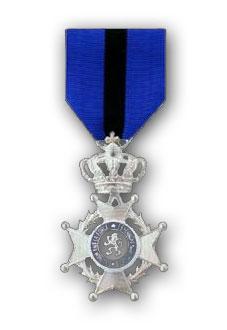
Chevalier de l'Ordre de Léopold II / Ridder in de Orde van Leopold II (Knight of the Order of Leopold II)
Translated into English as "Knight of the Order of Leopold II," this commendation is one of eight within the third highest order in the Belgian honours system. The Order of Leopold II was established in 1900 as a military award for bravery in combat or for meritorious service to the Belgian nation. It can be awarded to both Belgians and foreigners. John E. Bishop is the only member of the Newfoundland Regiment to have been awarded this honour during the First World War.
The medal for the Chevalier de l'Ordre de Léopold II is a silver cross on top of a silver wreath. At the centre of the cross is a blue enamel disc, with a black centre bearing a silver lion. The wreath and cross hang beneath a crown, which attaches to a blue ribbon with a thick black stripe in the middle. If the Order is awarded during wartime, silver crossed swords are attached to the ribbon.
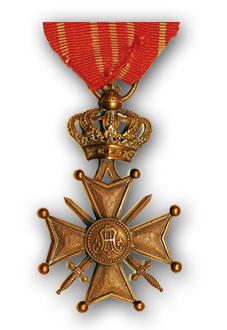
Croix de Guerre / Oorlogskruis (War Cross - Belgian)
Like France, Belgium also has a commendation called the Croix de Guerre (Cross of War). This medal was established in October 1915 to honour acts of heroism during the First World War. It could be awarded to Belgian soldiers as well as soldiers of any of the Allied powers whose acts of bravery took place on Belgian soil. It also could be awarded to a Belgian soldier to recognize three years of front-line service or in other special circumstances. Eight members of the Newfoundland Regiment received this award during the First World War.
The medal is a bronze cross on top of crossed swords. At the centre of the cross is a bronze disc bearing a lion. The cross is suspended from a bronze crown attached to a red ribbon with three thin green stripes on each side. The reverse of the medal is marked with the letter 'A' for King Albert I.
There are several levels of the Croix de Guerre, each determined by the rank of the commander recommending the commendation. Each level is marked by a pin on the ribbon as follows: a bronze palm indicates that the medal was awarded by the army; a bronze lion indicates that the medal was awarded by a regiment; and a gold lion indicates that the medal was issued by land forces.
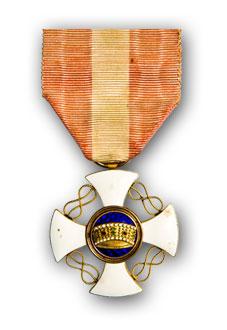
Ordine della Corona d'Italia - Cavaliere (Order of the Crown of Italy - Knight)
The Cavalier (Knight) of the Order of the Crown of Italy is the lowest of five levels in an Order established by King Victor Emmanuel II in 1868 to commemorate the Italian unification and honour civilian and military merit. It could be awarded to Italians or foreigners, civilians or soldiers, as a token of national gratitude for their accomplishments. Rupert Bartlett is the only member of the Newfoundland Regiment to have been awarded this honour during the First World War.
The badge of the Order of the Crown of Italy is a gilt cross, enameled in white, with gold "Savoy knots" (figure-eight knots) between the arms of the cross. At the centre of the cross is the Iron Crown on a blue enamel background. The reverse shows a golden disc with a black-enameled eagle bearing the coat of arms of Italy. A Cavalier of the Order wears the badge on a red-white-red ribbon on his left chest.
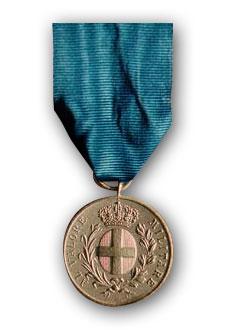
Medaglia Al Valore Militare di Bronzo (Bronze Medal for Military Valour - Italian)
The Medaglia Al Valore Militare is a commendation created in 1833 by Carlo Alberto Amedeo di Savoia, King of Piedmont-Sardinia, to recognize exceptional valour in battle (but which does not warrant the award of the Military Order of Savoia). The medal has three levels: gold, silver, and bronze. Arthur Webber, who received the bronze medal, is the only member of the Newfoundland Regiment to have been honoured with this award.
During the First World War, this circular medal depicted the royal shield of Savoia under a crown. The recipient's name was engraved on the reverse of the medal with the words "GUERRA DI 1915-1918" (War of 1915-1918). The medal was worn on a blue ribbon. For each subsequent act of valour, the recipient was awarded a bar to wear on the ribbon.
Medal of St. George (Russian)
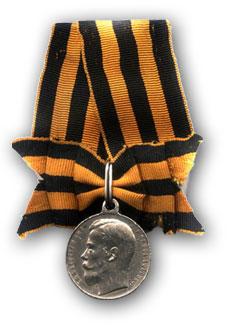
Instituted in 1878, the St. George Medal received its current name in 1913. This honour could be awarded to Russian and other Allied soldiers in four classes: gold medallions for first and second classes and silver medallions for third and fourth classes. George Phillips was the only member of the Newfoundland Regiment to win this award.
The obverse of the medal shows the head profile of Nicholas II (replaced by a representation of St. George slaying the dragon under the Provisional Government of 1917). The medal is worn from a yellow and black ribbon. A bow on the ribbon distinguishes 1st and 3rd classes from 2nd and 4th classes.

Shown above is on the reverse (FOR BRAVERY), the award number, and class.